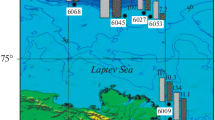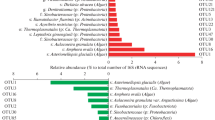Abstract
Diversity of methano- and methylotrophic bacteria in enrichments from the oxidized sediment layer maintained at 10°C in mineral media with nitrogen compounds (\({\text{NO}}_{3}^{ - }\) and \({\text{NH}}_{4}^{ + }\)) and methanol was studied using high-throughput sequencing of the V2–V3 region of the 16S rRNA gene. Methanotrophs of the bottom sediment belonged to the order Methylococcales, with predominance of the genus Methylobacter (6.4 and 4.6% of the total number of sequences, respectively). Members of the methylotrophic community belonged to the genus Methylotenera (family Methylophilaceae). Enrichments in the medium with ammonium and methane were characterized by the highest diversity of methanotrophs, containing 22 OTUs of the family Methylococcaceae, nine of which were not detected under other cultivation conditions. Altogether, only six out of 28 OTUs of methanotrophic bacteria exhibited similarity to cultured members of Methylobacter, Metyloglobulus, and Methylomicrobium, while others showed different levels of similarity (94–99%) to uncultured members of the family Methylococcaceae. The presence of 0.01% methanol promoted preferential development of methylotrophic bacteria, while 0.5% methanol suppressed the growth of methanotrophic bacteria irrespective of the nitrogen source added.




Similar content being viewed by others
REFERENCES
Beck, D.A.C., Kalyuzhnaya, M.G., Malfatti, S., Tringe, S.G., Glavina del Rio, T., Ivanova, N., Lidstrom, M.E., and Chistoserdova, L., A metagenomic insight into freshwater methane-utilizing communities and evidence for cooperation between the Methylococcaceae and the Methylophilaceae, PeerJ., 2013, vol. 1, e23–e23. https://doi.org/10.7717/peerj.23
Bodelier, P.L.E., Roslev, P., Henckel, T., and Frenzel, P., Stimulation by ammonium-based fertilizers of methane oxidation in soil around rice roots, Nature, 2000, vol. 403, pp. 421–424. https://doi.org/10.1038/35000193
Bol’shakov, A.M. and Egorov, A.V., On the use of phase-equilibrium degassing technique during gasometry studies in water basins, Okeanologiya, 1987, vol. 37, pp. 861–862.
Bukin, S.V., Pavlova, O.N., Kalmychkov, G.V., Ivanov, V.G., Pogodaeva, T.V., Galachyants, Yu.P., Bukin, Yu.S., Khabuev, A.V., and Zemskaya, T.I., Substrate specificity of methanogenic communities from lake Baikal bottom sediments associated with hydrocarbon gas discharge, Microbiology (Moscow), 2018, vol. 87, pp. 549–558. https://doi.org/10.1134/S0026261718040045
Cabello-Yeves, P.J., Zemskaya, T.I., Zakharenko, A.S., Sakirko, M.V., Ivanov, V.G., Ghai, R., and Rodriguez-Valera, F., Microbiome of the deep Lake Baikal, a unique oxic bathypelagic habitat, Limnol. Oceanogr., 2020, vol. 65, pp. 1471–1488. https://doi.org/10.1002/lno.11401
Chernitsyna, S.M., Mamaeva, E.V., Lomakina, A.V., Pogodaeva, T.V., Galach’yants, Y.P., Bukin, S.V., Khlystov, O.M., Zemskaya, T.I., and Pimenov, N.V., Phylogenetic diversity of microbial communities of the Posolsk bank bottom sediment, Lake Baikal, Microbiology (Moscow), 2016, vol. 85, pp. 672–680. https://doi.org/10.1134/S0026261716060060
Crevecoeur, S., Vincent, W.F, Comte, J., Matveev, A., and Lovejoy, C., Diversity and potential activity of methanotrophs in high methane-emitting permafrost thaw ponds, PLoS One, 2017, vol. 12, pp. 1–22. https://doi.org/10.1371/journal.pone.0188223
Dam, B., Dam, S., Kim, Y., and Liesack, W., Ammonium induces differential expression of methane and nitrogen metabolism-related genes in Methylocystis sp. strain SC2, Environ. Microbiol., 2014, vol. 16, pp. 3115–3127. https://doi.org/10.1111/1462-2920.12367
De Batist, M., Klerkx, J., Rensbergen, V., Vanneste, M., Poort, J., Golmshtok, A.Y., Kremlev, A., Khlystov, O.M., and Krinitsky, P., Active hydrate destabilisation in Lake Baikal, Siberia, Terra Nova, 2002, vol. 14, pp. 436–442. https://doi.org/10.1130/0091-7613(2002)030<0631:SMVAMS>2.0.CO;2
Deutzmann, J.S., Hoppert, M., and Schink, B., Characterization and phylogeny of a novel methanotroph, Methyloglobulus morosus gen. nov., spec. nov., Syst. Appl. Microbiol., 2014, vol. 37, pp. 165–169. https://doi.org/10.1016/j.syapm.2014.02.001
Dixon, J.L., Sargeant, S., Nightingale, P.D., and Murrell, J.C., Gradients in microbial methanol uptake: productive coastal upwelling waters to oligotrophic gyres in the Atlantic Ocean, Int. Soc. Microb. Ecol., 2013, vol. 7, pp. 568–580. https://doi.org/10.1038/ismej.2012.130
Fox, B.G., Froland, J.E., Dege, J., and Lipscomb, J.D., Methane monooxygenase from Methylosimis trichosporiwn OB3b: purification and properties of a three component system with high specific activity from a type II methanotroph, J. Biol. Chem., 1989, vol. 264, pp. 10023–10033.
Gal’chenko V.F., Metanotrofnye bakterii (Methanotrophic Bacteria), Moscow: GEOS, 2001.
Golubev, V.A., Thermal structure and statistical stability of bottom waters of Lake Baikal, Vodnye Resursy, 1981, no. 6, pp. 75–89.
Hanson, R. and Hanson, T., Methanotrophic bacteria, Microbiol Rev., 1996, vol. 60, pp. 439–471.
He, R., Wooller, M., Pohlman, J., Catranis, C., Quensen, J., Tiedje, J., and Leigh, M., Identification of functionally active aerobic methanotrophs in sediments from an arctic lake using stable isotope probing, Environ. Microbiol., 2012, vol. 14, pp. 1403–1419. https://doi.org/10.1111/j.1462-2920.2012.02725.x
Kadnikov, V.V., Mardanov, A.B., Beletsky, A.V., Shubenkova, O.V., Pogodaeva, T.N., Zemskaya, T.I., Ravin, N.V., and Skryabin, K.G., Microbial community structure in methane hydrate-bearing sediments of freshwater Lake Baikal, FEMS Microbiol. Ecol., 2012, vol. 79, pp. 348–358. https://doi.org/10.1111/j.1574-6941.2011.01221.x
Kalyuzhnaya, M.G., Lapidus, A., Ivanova, N., Copeland, A.C., McHardy, A.C., Szeto, E., Salamov, A., Grigoriev, I.V., Suciu, D., Levine, S.R., Markowitz, V.M., Rigoutsos, I., Tringe, S.G., Bruce, D.C., Richard-son, P.M., et al., High-resolution metagenomics targets specific functional types in complex microbial communities, Nature Biotechnol., 2008, vol. 26, pp. 1029–1034.
Kalyuzhnaya, M.G., and Xing, X.H., Methane Biocatalysis: Paving the Way to Sustainability, 2018. https://doi.org/10.1038/nbt.1488
Khlystov, O., De Batist, M., Shoji, H., Hachikubo, A., Nishio, S., Naudts, L., Poort, J., Khabuev, A., Belousov, O., Manakov, A., and Kalmychkov, G., Gas hydrate of Lake Baikal: discovery and varieties, J. Asian Earth Sci., 2013, vol. 62, pp. 162–166. https://doi.org/10.1016/j.jseaes.2012.03.009
Kozich, J.J., Westcott, S.L., Baxter, N.T., Highlander, S.K., and Schloss, P.D., Development of a dual-index sequencing strategy and curation pipeline for analyzing amplicon sequence data on the MiSeq Illumina sequencing platform, Appl. Environ. Microbiol., 2013, vol. 79, pp. 5112–5120. https://doi.org/10.1128/AEM.01043-13
Kuznetsov, S.I. and Dubinina, G.A., Metody izucheniya vodnykh mikroorganizmov (Methods of Studying Aquatic Microorganisms), Moscow: Nauka, 1989.
Liikanen, A. and Martikainen, P.J., Effect of ammonium and oxygen on methane and nitrous oxide fluxes across sediment–water interface in a eutrophic lake, Chemosphere, 2003, vol. 52, pp. 1287–1293.
Lomakina, A., Mamaeva, E., Pogodaeva, T., Kalmychkov, G., Khalzov, I., and Zemskaya, T., Anaerobic methane oxidation in enrichment cultures from deep sediments of a mud volcano Peschanka (South Baikal), Microbiology (Moscow), 2018, vol. 87, pp. 317–325. https://doi.org/10.1134/S0026261718030049
Martin, P., Granina, L.Z., Martens, K., and Goddeeris, B., Oxygen concentration profiles in sediments of two ancient lakes: Lake Baikal (Siberia, Russia) and Lake Malawi (East Africa), Hydrobiologia, 1998, vol. 367, pp. 163–174.
Muller, B., Maerki, M., Schmid, M., Vologina, E.G., Wehrli, B., Wuest, A., and Sturm, M., Internal carbon and nutrient cycling in Lake Baikal: sedimentation, upwelling, and early diagenesis, Global Planet. Change, 2005, vol. 46, pp. 101–124.
Murase, J. and Sugimoto, A., Inhibitory effect of light on methane oxidation in the pelagic water column of a mesotrophic lake (Lake Biwa, Japan), Limnol. Oceanogr., 2005, vol. 50, pp. 1339–1343.
Namsaraev, B.B. and Zemskaya, T.I., Mikrobiologicheskie protsessy krugovorota ugleroda v donnykh osadkakh ozera Baikal (Microbiological Processes of the Carbon Cycle in Bottom Sediments of Lake Baikal), Novosibirsk: GEO, 2000. Nyerges, G. and Stein, L.Y., Ammonia cometabolism and product inhibition vary considerably among species of methanotrophic bacteria, FEMS Microbiol. Lett., 2009, vol. 297, pp. 131–136. https://doi.org/10.1111/j.1574-6968.2009.01674.x
Op den Camp, H., Islam, T., Stott, M., Harhangi, H., Hynes, A., Schouten, S., Jetten, M., Birkeland, N., Pol, A., and Dunfield, P., Minireview: environmental, genomic, and taxonomic perspectives on methanotrophic Verrucomicrobia, Environ. Microbiol. Rep., 2009, vol. 1, pp. 293–306.
Pogodaeva, T.V., Zemskaya, T.I., and Khlystov, O.M., Preliminary estimate of dissolved components flowing through water-bottom interface at sites of oil and gas discharge in Lake Baikal, Proc. 11th Conf. on Gas in Marine Sediments, Nice, 2012, p. 74.
Pogodaeva, T.V., Lopatina, I.N., Khlystov, O.M., Egorov, A.V., and Zemskaya, T.I., Background composition of pore waters in Lake Baikal bottom sediments, J. Great Lakes Res., 2017, vol. 43, pp. 1030–1043. https://doi.org/10.1016/j.jglr.2017.09.003
Pogodaeva, T.V., Sypachev, R.I., Akhmanov, G.G., and Khlystov, O.M., Geochemistry of gas-saturated fluids of mud volcanoes and methane seeps (Lake Baikal), VIII Mezhdunarodnaya nauchno-prakticheskaya konferenziya “Morskie issledovania i obrazovanie” (Proc. VIII Int. Conf. “Marine Research and Education. Maresedu-2019” (Moscow, Shirshov Institute of Oceanology, Russian Academy of Sciences), Tver: PoliPRESS, 2019, vol. 2, pp. 71–73.
Reeburgh, W.S., Oceanic methane biogeochemistry, Chem. Rev., 2007, vol. 107, pp. 486–513.
Schloss, P.D., Westcott, S.L., Ryabin, T., Hall, J.R., Hartmann, M., Hollister, E.B., Lesniewski, R. A., Oakley, B.B., Parks, D.H., Robinson, C.J., Sahl, J.W., Stres, B., Thallinger, G.G., Van Horn, D.J., and Weber, C.F., Introducing mothur: open-source, platform-independent, community-supported software for describing and comparing microbial communities, Appl. Environ. Microbiol., 2009, vol. 75, pp. 7537–7541. https://doi.org/10.1128/AEM.01541-09
Shubenkova, O.V., Zemskaia, T.I., Chernitsyna, S.M., Kh-lystov, O.M., and Triboĭ, T.I., The first results of an investigation into the phylogenetic diversity of microorganisms in Southern Baikal sediments in the region of subsurface discharge of methane hydrates, Microbiology (Moscow), 2005, vol. 74, pp. 370–377.
Tays, C., Guarnieri, M.T., Sauvageau, D., and Stein, L.Y., Combined effects of carbon and nitrogen source to optimize growth of proteobacterial methanotrophs, Front. Microbiol., 2018, vol. 9, pp. 1–14. https://doi.org/10.3389/fmicb.2018.02239
Trotsenko Yu.A. and Khmelenina V.N., Extremal’nye metanotrofy (Extremophilic Methanotrophs), Pushchino: Izd. Otd. Nanotechnol. Int. Technol., 2008.
Vorob’ev, A.V. and Dedysh, S.N., Inadequacy of enrichment culture technique for assessing the structure of methanotrophic communities in peat soil, Microbiology (Moscow), 2008, vol. 77, pp. 504–507.
Whittenbury, R., Philips, K., Wilkinson, J., Enrichment isolation and some properties of methane-utilizing bacteria, J. Gen. Microbiol., 1970, vol. 61, pp. 205–218.
Yang, Y., Tong, T., Chen, J., Liu, Y., and Xie, S., Ammonium impacts methane oxidation and methanotrophic community in freshwater sediment, Front. Bioeng. Biotechnol., 2020, vol. 20, pp. 1–11. https://doi.org/10.3389/fbioe.2020.00250
Zakharenko, A.S., Galachyants, Y.P., Morozov, I.V., Shubenkova, O.V., Morozov, A.A., Ivanov, V.G., Pimenov, N.V., Krasnopeev, A.Y., and Zemskaya, T.I., Bacterial communities in areas of oil and methane seeps in pelagic of Lake Baikal, Microb. Ecol., 2019, vol. 78, pp. 269–285. https://doi.org/10.1007/s00248-018-1299-5
Zemskaya, T.I., Khlystov, O.M., Egorov, A.V., Pogodaeva, T.V., Kalmychkov, G.V., Shubenkova, O.V., Chernitsina, S.M., Vorob’eva, S.S., and Grachev, M.A., Komplexnye issledovaniya proyavlenii gazovykh gidratov v osadkakh gryazevykh vukanov ozera Baikal. Izmenenie okruzhayushchei sredy i klimata i svyazannye s nimi prirodnye i technogennye katastrofy (Complex Research of Gas Hydrate Phenomena in Sediments of Mud Volcanoes of Lake Baikal. Environmental and Climate Changes and Associated Natural and Technogenic Catastrophes), Moscow: Inst. Physics Earth, 2008.
Zemskaya, T.I., Pogodaeva, T.V., Shubenkova, O.V., Chernitsyna, S.M., Dagurova, O.P., Buryukhaev, S.P., Namsaraev, B.B., Khlystov, O.M., Egorov, A.V., Krylov, A.A., and Kalmychkov, G.V., Geochemical and microbiological characteristics of sediments near the Malenky mud volcano (Lake Baikal, Russia), with evidence of Archaea intermediate between the marine anaerobic methanotrophs ANME-2 and ANME-3, Geo-Mar. Lett., 2010, vol. 30, pp. 411–425. https://doi.org/10.1007/s00367-010-0199-6
Zemskaya, T.I., Lomakina, A.V., Shubenkova, O.V., Pogodaeva, T.V., Morozov, I.V., Chernitsina, S.M., Sitnikova, T.Ya., Khlystov, O.M., and Egorov, A.V., Jelly-like microbial mats over subsurface fields of gas hydrates at the St. Petersburg methane seep (Central Baikal), Geomicrobiol. J., 2015, vol. 32, pp. 89–100. https://doi.org/10.1080/01400451.2014.910572
ACKNOWLEDGMENTS
The authors are grateful to the Irkutsk Supercomputing Center of the Siberian Branch of the Russian Academy of Sciences for the provided access to the HPC cluster Academician V.M. Matrosov.
Funding
This work was conducted according to the State Assignment theme no. 0279-2021-0006 with financial support of the Russian Foundation for Basic Research, project no. ofi_m 17-29-05040.
Author information
Authors and Affiliations
Corresponding author
Ethics declarations
Conflict of interests. The authors declare that they have no conflict of interest.
Statement on the welfare of animals. This article does not contain any studies involving animals or human participants performed by any of the authors.
Additional information
Translated by D. Timchenko
Rights and permissions
About this article
Cite this article
Shubenkova, O.V., Zakharenko, A.S., Galach’yants, Y.P. et al. Effect of Methanol and Mineral Nitrogen Compounds on the Composition of Methanotrophic Enrichments from the Sediments of a Lake Baikal Methane Seep. Microbiology 90, 443–454 (2021). https://doi.org/10.1134/S0026261721040123
Received:
Revised:
Accepted:
Published:
Issue Date:
DOI: https://doi.org/10.1134/S0026261721040123




